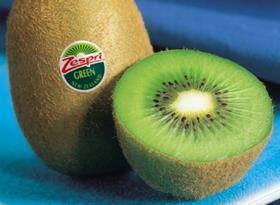
New Zealand’s single desk kiwifruit marketer Zespri continues to feel the pinch from the Psa vine-killing disease, despite delivering its highest-ever average orchard gate return (OGR) of NZ$51,153 (US$41,318) to New Zealand growers over the 2012/2013 season.
The record returns are largely due to the performance of the Zespri Green category, which accounts for close to 70 per cent of the company’s export volume.
Average per-tray green returns increased by 21 percent to NZ$4.62 (US$3.73) over the 12 month period, their highest level since 2003/04.
“Strong underlying demand created by over a decade of investment in the Zespri brand has delivered a substantial competitive advantage and premium to New Zealand growers,” Zespri chairman Peter McBride said.
“Delivering the highest Green per-tray OGR for ten years is particularly impressive, considering the operating environment in 2003 was considerably more favourable than today, in terms of foreign exchange rates and a much smaller volume – 49.9m trays in 2003/04, as compared to 71.4m trays last financial year.”
Challenges still lay ahead
The total volume of Zespri Kiwifruit sold fell by 5 per cent in 2012/13 to 110.1m trays, with New Zealand-grown supply at 101.3m trays.
Sales for the Zespri Gold category were also down in 2012/2013, falling 16 per cent to 24.6m trays.
Zespri Chief Executive Lain Jager attributed the decline to the impact Psa has had on the company’s original gold variety, Hort16a, which has proven to be extremely susceptible to the bacterial disease.
Zespri has embarked on a recovery pathway programme with its growers, aimed at moving the production base to Zespri’s newly licensed Gold3 variety.
Jager said the transition process would take time.
“This impact will be even more pronounced in 2013/14, with gold volumes down to around 13m trays for the year,” Jager explained.
“We expectgold volumes will begin to recover after the 2013 season with around 1,860ha of the Psa-sensitive Hort16a canopy grafted over to the more Psa-tolerant Gold3 in 2012/13.”
Psa is not the only challenge the company is facing.
“The high New Zealand dollar continues to cause a significant impact on our business – costing each grower on average 43 cents per tray this financial year relative to the previous year – and it’s unlikely that short-term relief is in sight,” Jager said.
Corporate results
Zespri’s net profit after tax for 2012/2013 was NZ$7.6m (US$6.1m), significantly down on NZ$20.5m (US$16.6m) in 2011/12.
The company pointed out that when adjusting for the impacts of funding for Psa, the like-for-like comparison sees profit reduced from NZ$16.4m (US$13.2m) to NZ$10.7m (US$8.6m).
These results also include provision for the court-imposed penalties and US$950,000 fine handed out to Zespri’s Chinese subsidiary by a Shanghai Court in April, for the under-declaration of customs duties between 2008 and 2010.
Chinese growth
Ironically, China was one of Zespri’s major success stories from a trade perspective over the last 12 months, with volumes sold to the Asian country up 9 per cent to 10m trays.
Chinese market returns were up 21 per cent compared with 2011/12, to $117.3m (US$94.7m), making up 11 percent of Zespri’s total market returns.
“It is well known that we have been dealing with some challenging issues in China, including transitioning to a new management team and improving our business practices – but we have been determined to make that transition without disrupting the business,” McBride said.
“This result suggests our management, together with our new import partners, are achieving both our change management and sales objectives.”



